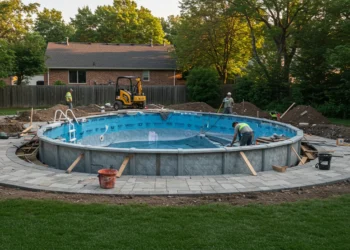In recent times, there has been a significant rise in the popularity of sustainable landscaping practices as people recognise the importance of safeguarding the environment. Among these practices, permeable pavement has emerged as a point. This innovative technique enables water to seep through the pavement surface, thereby reducing runoff and preserving groundwater resources. In this post, we will explore some of the developments in pavement, highlighting their advantages, practical applications, and advancements.
Advantages of Permeable Pavement
1. Effectively Managing Stormwater Runoff
One of the benefits associated with pavement is its excellent ability to manage stormwater runoff. Unlike surfaces such as concrete and asphalt that impede rainwater infiltration into the ground, permeable pavement from companies like Stone Set utilises specific materials and designs that facilitate water drainage through void spaces or micro-perforations. By promoting infiltration, it aids in replenishing groundwater supplies while simultaneously alleviating pressure on drainage systems.
Know more about Above-ground Swim Spa Landscaping Ideas
2. Temperature Regulation
Another advantage offered by pavement lies in its capability to regulate temperatures effectively. In contrast to paving materials that absorb heat and contribute to heat island effects, permeable pavements generally maintain a cooler surface temperature due to their ability to allow moisture evaporation and maintain heat equilibrium with ambient air temperatures.
This cooling effect not only makes walking or driving on surfaces more comfortable but also reduces the need for air conditioning, resulting in lower overall energy consumption.
Latest Trends in Permeable Pavement
1. Sustainable Materials
A growing trend in pavement design focuses on using materials like recycled aggregates instead of traditional options such as gravel or crushed stone. These recycled materials, including rubble or reclaimed asphalt pavement (RAP), help divert waste from landfills while still providing load-bearing capacity and water infiltration capabilities.
Furthermore, incorporating sourced aggregates that require less energy-intensive transportation aligns with environmentally conscious principles. Ongoing innovations in pavement aim to reduce the carbon footprint and make sustainable materials more accessible to contractors and landscapers
2. Performance Monitoring and Maintenance
Ensuring the long-term effectiveness of pavements now relies heavily on performance monitoring and maintenance as essential practices for sustainable landscaping. One notable trend involves utilising embedded sensors or monitoring systems that provide real-time data on water flow, infiltration rates and temperature fluctuations.
By tracking these parameters, property owners or managers can promptly identify issues such as clogged drains or reduced infiltration capacity. Proactive methods, like vacuum sweeping, frequent surface cleaning and occasional power washing, can help prevent issues from escalating and prolong the lifespan of pavement systems.
3. Improved Visual Appeal
While functionality remains crucial in considering pavements, designers are now paying attention to integrating aesthetics with sustainable features. Advancements in manufacturing technology have made it possible to create options without compromising drainage capabilities. Property owners now have a range of choices when it comes to textures, shapes, colours or customised patterns that enhance their spaces while still promoting responsible water management.
Innovative Solutions
Apart from the trends in material selection and design aesthetics mentioned above, researchers and manufacturers are constantly introducing solutions in the field of pavement:
- Pervious Concrete: This specialised concrete mixture has more porosity than concrete but still maintains sufficient structural integrity for vehicular loads. Its interconnected void structure enables management.
- Porous Asphalt: With a percentage of interconnected voids within its composition, porous asphalt allows water infiltration into the underlying stone bed. When combined with stone subsurfaces designed for water storage capacity, porous asphalt significantly enhances management performance.
Final Thoughts
Permeable pavement has gained popularity as a landscaping option. It not only helps effectively manage runoff but also offers additional advantages like regulating temperature. If you’re interested in incorporating pavement into your spaces, it’s essential to stay updated on the latest trends in materials, design aesthetics and maintenance practices.
By embracing these approaches and continuously exploring advancements in the industry, we can contribute to creating environments that are more environmentally friendly and safeguard our precious water resources. So, whether you’re a homeowner or a professional landscaper, consider joining in the movement of using pavement and contributing to building a greener future.








